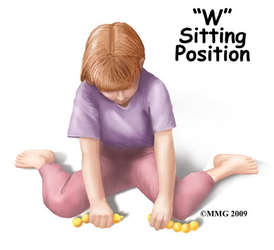| W--sitting is a position of sitting on the floor – the child sits on their bottom with their knees bent and rotated on the floor behind them in the shape of a W. Many children W-sit and move in and out of this position during play. All children should be discouraged for sitting in this position. When W-sitting becomes the primary way of sitting, it can hinder development. When playing in other postures, such as tailor sit (legs crisscrossed), long sit (legs straight out in front), or side sit (legs bent at the knees with both knees facing either left or right), children develop the trunk control and trunk rotation that is necessary for crossing midline (reaching across the body) and for separation of the two sides of the body (bilateral coordination). These skills are needed for a child to develop refined motor skills and hand dominance. |

- This position can lead to decreased stability in the hips and trunk.
- This position leads to orthopedic problems with hips, knees, and feet, including hip dislocation, knee instability, and “pigeon toeing”.
- If there is muscle tightness, W-sitting with aggravate it by placing the hamstrings, hip adductors, and heel cords in a shortened range.
- If a child has increased muscle tone, W-sitting will feed into the abnormal patterns of movement.
- If a child has decreased muscle tone, the child collapses into the position.
- W-sitting can discourage a child from developing hand preference because the child is less inclined to reach across the body, and instead picks up objects on the right with the right hand, and those placed to the left with the left hand.
Why do children W-sit?
Every child needs to play and children who are challenged motorically like to play as much as anybody. They don’t want to worry about keeping their balance when they’re concentrating on a toy. Children who are frequent W-sitters often rely on this position for added trunk and hip stability to allow easier toy manipulation and play. This position limits active trunk control and development of the trunk muscles for independent sitting. If the child prefers to sit in this manner, it may be difficult to change the habit due to decreased strength in the trunk.
When in the W-position, a child is planted in place or “fixed” through the trunk. This allows for play with toys in front, but does not permit trunk rotation and lateral weight shifts (twisting and turning to reach toys on either side). Trunk rotation and weight shifts over one side allow a child to maintain balance while running outside or playing on the playground and are necessary for crossing the midline while writing and doing table top activities. W-sitting provides the child with a stable trunk and hips, which allows the child more freedom to use their hands to play without challenging their balance.
The most effective way to prevent a problem with W-sitting is to prevent it from becoming a habit in the first place. If the child has discovered W-sitting already, verbally cue them to “fix your legs” and assist him or her to transition into a more functional position. When playing with your child on the floor in the kneeling position, hold their knees close together. If a child is unable to sit alone in any position other than a W, provide a back rest for them to lean against (e.g. couch, pillow, etc.). If changing the seated position is not working, get the child off of the floor by having them play while seated in a chair or on a bench.
If you have any additional questions please feel free to ask one of our occupational therapists for more information.




 RSS Feed
RSS Feed
